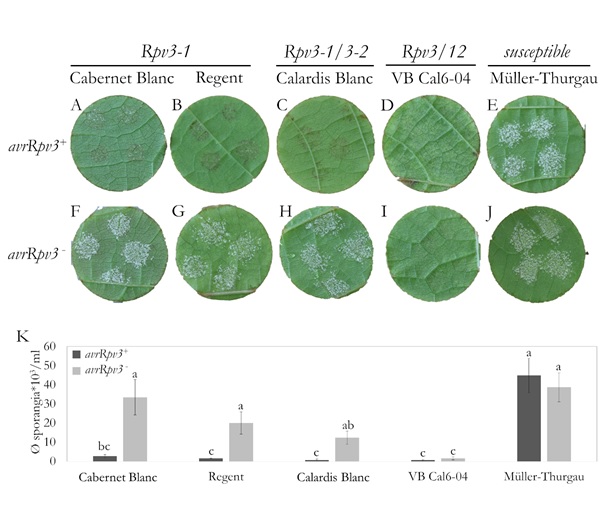The Rpv3- and Rpv12-dependent defense mechanism against Plasmopara viticola and its implications for crop protection management
Supported by state funds and co-financed by the European Regional Development Fund (ERDF) as part of the INTERREG V Upper Rhine Vitifutur program
This project was carried out as part of a doctoral thesis by Birgit Eisenmann from October 2015 to February 2019
Summary of the project
Viticulture is based on traditional European grape varieties(Vitis vinifera) that are highly susceptible to downy mildew(Plasmopara viticola). The high susceptibility of the European grapevine to this pathogen requires the intensive use of fungicides to prevent significant losses in yield and quality. Based on naturally occurring resistant vines in North America and Asia, intensive breeding of new, fungus-resistant grape varieties has taken place in recent decades. This was linked to the aim of reducing the number of plant protection treatments through the plant's own resistance to harmful fungi. However, despite the obvious economic and ecological advantages and the now good quality of the products, only around 2.4 % of vineyards in Germany are planted with resistant varieties. The reasons for this very low cultivation area of fungus-resistant grape varieties include a lack of knowledge about adapted plant protection strategies for these new varieties.
In order to promote the cultivation of fungus-resistant grape varieties, detailed knowledge of the variety-specific resistance characteristics and the associated number and timing of plant protection treatments under the given climatic conditions and prevailing weather must be available. Therefore, field trials with two fungus-resistant grape varieties (Cabernet Blanc(Rpv3) and VB Cal6-04 (Sauvignac)(Rpv3/12) were carried out as part of this work. The results of these experiments show that a fungicide reduction of 50 % to 75 % is possible without negative effects on quality or quantity, depending on weather conditions, vine development and resistance loci. In addition, it has been shown that eliminating plant protection treatments can have serious effects on yield, quality and plant health.
Understanding the resistance mechanisms mediated by different resistance loci is essential for breeding new varieties, as combining different resistance mechanisms would reduce the likelihood of the pathogen overcoming plant resistance. To obtain more information on the Rpv3- and Rpv12-mediatedresistance mechanisms, comparative microscopic studies as well as metabolome and transcriptome analyses were performed. Rpv3-mediated defense was analyzed in more detail using a new approach applied in this study. It consisted of investigating a successful and unsuccessful defense response in an Rpv3 genotype by inoculation with a P. viticola isolate avirulent or virulent to the Rpv3 locus(Fig. 1). Since there is no rapid and routine way to generate mutants in grapevine, this approach provided a new opportunity to gain further insight into Rpv3-mediated defense against P. viticola. The results of this work suggest that the resistance mediated by the Rpv3 and Rpv12 locusis achieved by two distinct mechanisms. Resistance mediated by the Rpv12 locusis activated faster and more effectively than Rpv3-mediated defense, resulting in earlier cell death, which occurred 8 hours post inoculation (hpi), and strong growth inhibition, which nearly halted pathogen development within 24 hpi. Successful Rpv3-mediated defense is associated with demonstrated cell death after 24-32 hpi and synthesis of toxic stilbenes, resulting in partial resistance with reduced but not completely suppressed growth of P. viticola.
So far, only two resistance genes involved in the recognition of pathogenic structures have been described in grapevine. To identify new genes involved in Rpv3-mediated resistance, an RNA sequencing experiment was performed. Functional annotation of the encoded protein sequence of genes that were significantly upregulated during the Rpv3-mediated defense response indicates a putative function in the downstream Rpv3 resistance mechanism after pathogen recognition.

Dr. Birgit Eisenmann
Downloads

Figure 1: Sporulation of a virulent (overcoming the resistance locus) and avirulent (unable to overcome the resistance locus) Plasmopara viticola isolate on susceptible and fungus-resistant genotypes. Leaf discs of the Rpv3-1 locus containing the grape varieties (A, F) Cabernet Blanc and (B, G) Regent, the Rpv3-1 and Rpv3-2 loci containing variety (C, H) Calardis Blanc, the Rpv3/12 genotype(D, I) VB Cal6-04 and the susceptible grape variety (E, J) Müller-Thurgau were tested with the avirulent(avrRpv3+) (top) and virulent(avrRpv3¯) (bottom) P. viticola isolate. Pictures of representative leaf discs were taken 6 days after inoculation. (K) Sporulation of P . vit icola isolates on leaf disks. Sporangia were counted 6 days after inoculation. Bars represent the average of three independent experiments with four replicates (plants) and 40 evaluated leaf disks each. The error bars show the standard deviation. Means with different letters (a, b, c) are significantly different (p<0.05).
Publications:
Eisenmann et al (2019): Rpv3-1 mediated resistance to grapevine downy mildew is associated with specific host transcriptional responses and the accumulation of stilbenes. In: BMC Plant Biology 19
Eisenmann Birgit (2019): Grapevine defense responses in Rpv3- and Rpv12-dependent resistance against Plasmopara viticola and their implication for crop protection management. Dissertation
Eisenmann (2018): Saving fungicides. In: German viticulture
Eisenmann, Kortekamp and Bogs (2017): Resistance fighters against mildew.
